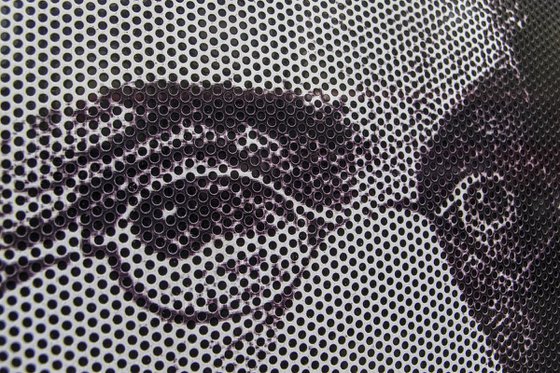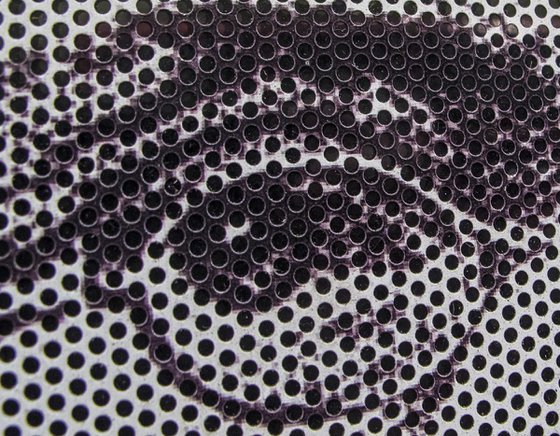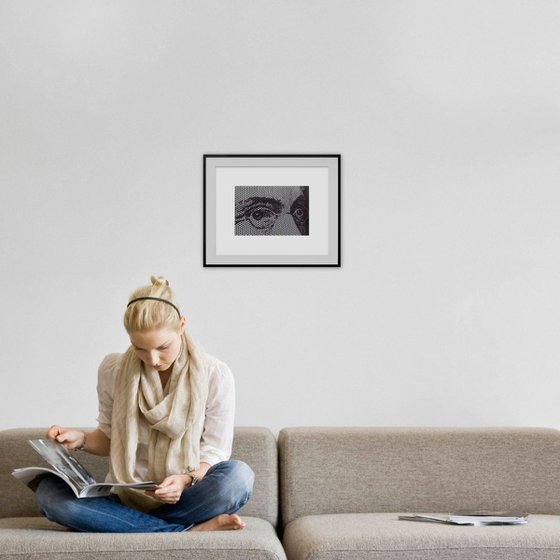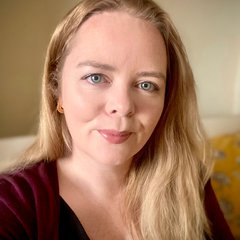- By medium
- By subject
- By budget
- Sales
- Gift cards
- Discover all art
- Artists
- Editors’ picks
- Ideas
Artwork description:
EYES By Laura Fitzpatrick
(LIMITED EDITION 2/200) 12" X 8"
This photo is from my close-up London projects.
It amazing how different something can look and feel the closer you move in.
I love how the close-up on Sir Charles Wheatstone eyes has a POP ART feel and that you can quite easily fall into a trance looking into this great masters eyes.
Sir Charles Wheatstone, (born Feb. 6, 1802, Gloucester, Gloucestershire, Eng.—died Oct. 19, 1875, Paris), English physicist who popularized the Wheatstone bridge, a device that accurately measured electrical resistance and became widely used in laboratories.
Wheatstone was appointed professor of experimental philosophy at King’s College, London, in 1834, the same year that he used a revolving mirror in an experiment to measure the speed of electricity in a conductor. The same revolving mirror, by his suggestion, was later used in measurements of the speed of light. Three years later, with Sir William Fothergill Cooke of England, he patented an early telegraph. In 1843, he brought to notice the Wheatstone bridge, a device invented by British mathematician Samuel Christie.
His own inventions include the concertina, a type of small accordion, and the stereoscope, a device for observing pictures in three dimensions still used in viewing X-rays and aerial photographs. He initiated the use of electromagnets in electric generators and invented the Playfair cipher, which is based on substituting different pairs of letters for paired letters in the message. He was knighted in 1868.
A NEW WAY TO SEE THIS AMAZING CITY
REFLECTIONS OF LONDON
Laura Fitzpatrick Urban Photographer LONDON
Tags:
#no:1 #london ri #summer colurs #ready for hanging #autumn lake reflection #inventions #ingenuity #closeup of leaf #sir charles wheatstone #charles wheatstone #abstract #contemporary #black and white #green #yellow #trees #pop art #art #tree #urban #monochrome #london #man #street art #surrealism #realistic #surreal #reflection #pattern #beautiful #unique #urban art #popart #circles #office decoration #natural #office art #london city #shadow #home decoration #peace #print on paper #positive energy #city of london #powerful #urban pop art #wall abstract art #trees. abstract woods #birthday gift #natural beauty #conversation piece #london bridge #nature photograph #gallery #photograph #lipstick #conversation starter #glasses #gallery art #colouful #london skyline #puddle #november #london eye #watercolor abstract art #red lipstick #westminster bridge #mirror art #birthday #summer sunshine #urban exposure #water abstract #urban portrait #popart person #circle abstract art #spectacular #royal park #yellow lines #summer morning #double #summer abstract #just walking #sunday afternoon #light & shadows #thames estuary #real life #natural art #rich bold colours #kings college #trance #aerial photograph #xray #gift shop #road marking #eveing light #inventor #masters #womam #john keats #double yellowFeatured by our Editors:
EYES (LIMITED EDITION 2/200) 12" X 8" (2015)
Photograph
by Laura Fitzpatrick
98 Artist Reviews
£30
- Photograph on Paper
- From a limited edition of 150
- Size: 30.48 x 20.32cm (unframed)
- Signed and numbered on the back
- Style: Urban and Pop
- Subject: Abstract and non-figurative
- Hurry only 1 left in stock
Loading
Artwork description
EYES By Laura Fitzpatrick
(LIMITED EDITION 2/200) 12" X 8"
This photo is from my close-up London projects.
It amazing how different something can look and feel the closer you move in.
I love how the close-up on Sir Charles Wheatstone eyes has a POP ART feel and that you can quite easily fall into a trance looking into this great masters eyes.
Sir Charles Wheatstone, (born Feb. 6, 1802, Gloucester, Gloucestershire, Eng.—died Oct. 19, 1875, Paris), English physicist who popularized the Wheatstone bridge, a device that accurately measured electrical resistance and became widely used in laboratories.
Wheatstone was appointed professor of experimental philosophy at King’s College, London, in 1834, the same year that he used a revolving mirror in an experiment to measure the speed of electricity in a conductor. The same revolving mirror, by his suggestion, was later used in measurements of the speed of light. Three years later, with Sir William Fothergill Cooke of England, he patented an early telegraph. In 1843, he brought to notice the Wheatstone bridge, a device invented by British mathematician Samuel Christie.
His own inventions include the concertina, a type of small accordion, and the stereoscope, a device for observing pictures in three dimensions still used in viewing X-rays and aerial photographs. He initiated the use of electromagnets in electric generators and invented the Playfair cipher, which is based on substituting different pairs of letters for paired letters in the message. He was knighted in 1868.
A NEW WAY TO SEE THIS AMAZING CITY
REFLECTIONS OF LONDON
Laura Fitzpatrick Urban Photographer LONDON
Tags:
#no:1 #london ri #summer colurs #ready for hanging #autumn lake reflection #inventions #ingenuity #closeup of leaf #sir charles wheatstone #charles wheatstone #abstract #contemporary #black and white #green #yellow #trees #pop art #art #tree #urban #monochrome #london #man #street art #surrealism #realistic #surreal #reflection #pattern #beautiful #unique #urban art #popart #circles #office decoration #natural #office art #london city #shadow #home decoration #peace #print on paper #positive energy #city of london #powerful #urban pop art #wall abstract art #trees. abstract woods #birthday gift #natural beauty #conversation piece #london bridge #nature photograph #gallery #photograph #lipstick #conversation starter #glasses #gallery art #colouful #london skyline #puddle #november #london eye #watercolor abstract art #red lipstick #westminster bridge #mirror art #birthday #summer sunshine #urban exposure #water abstract #urban portrait #popart person #circle abstract art #spectacular #royal park #yellow lines #summer morning #double #summer abstract #just walking #sunday afternoon #light & shadows #thames estuary #real life #natural art #rich bold colours #kings college #trance #aerial photograph #xray #gift shop #road marking #eveing light #inventor #masters #womam #john keats #double yellowFeatured by our Editors:
14 day money back guaranteeLearn more





